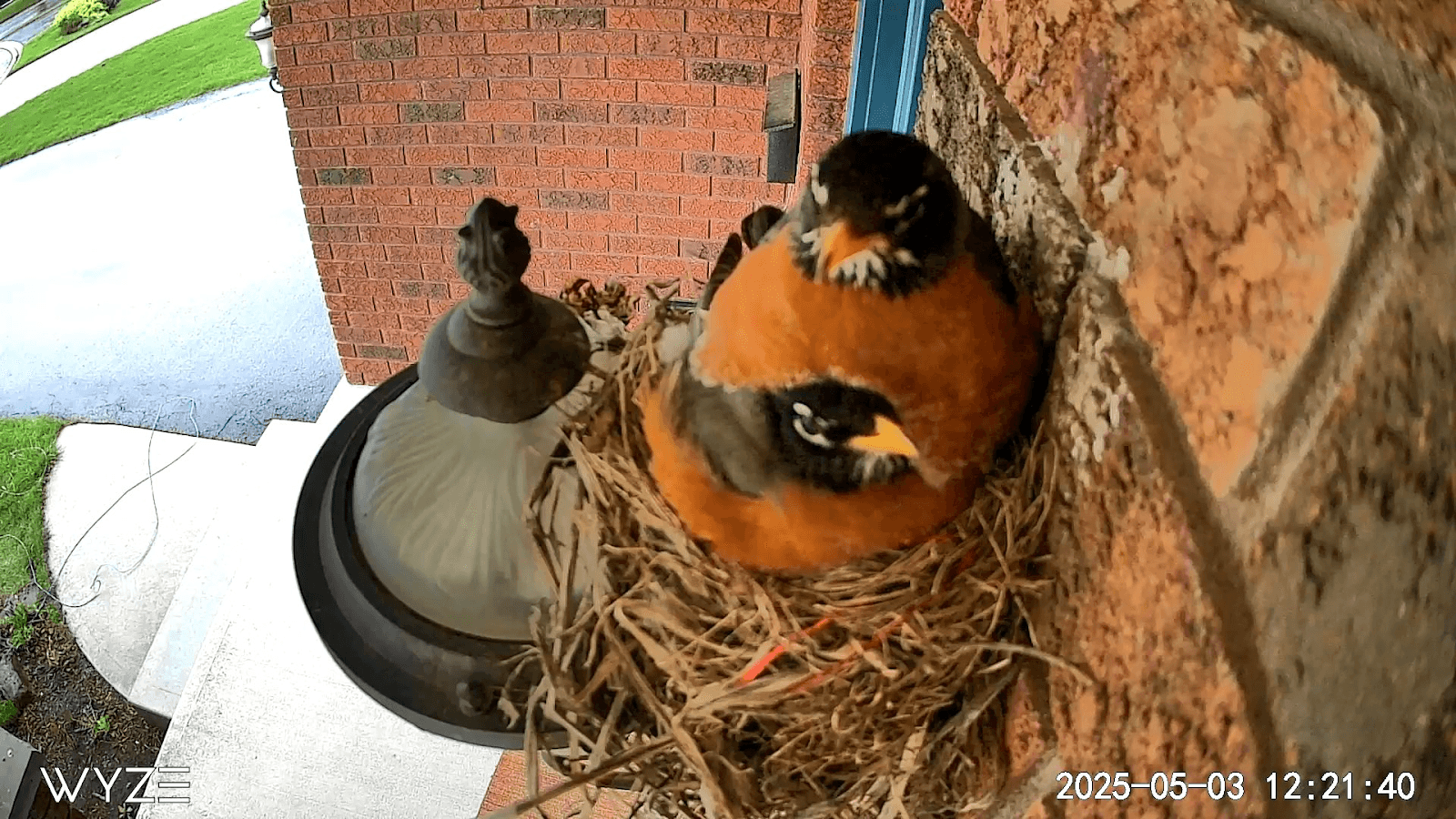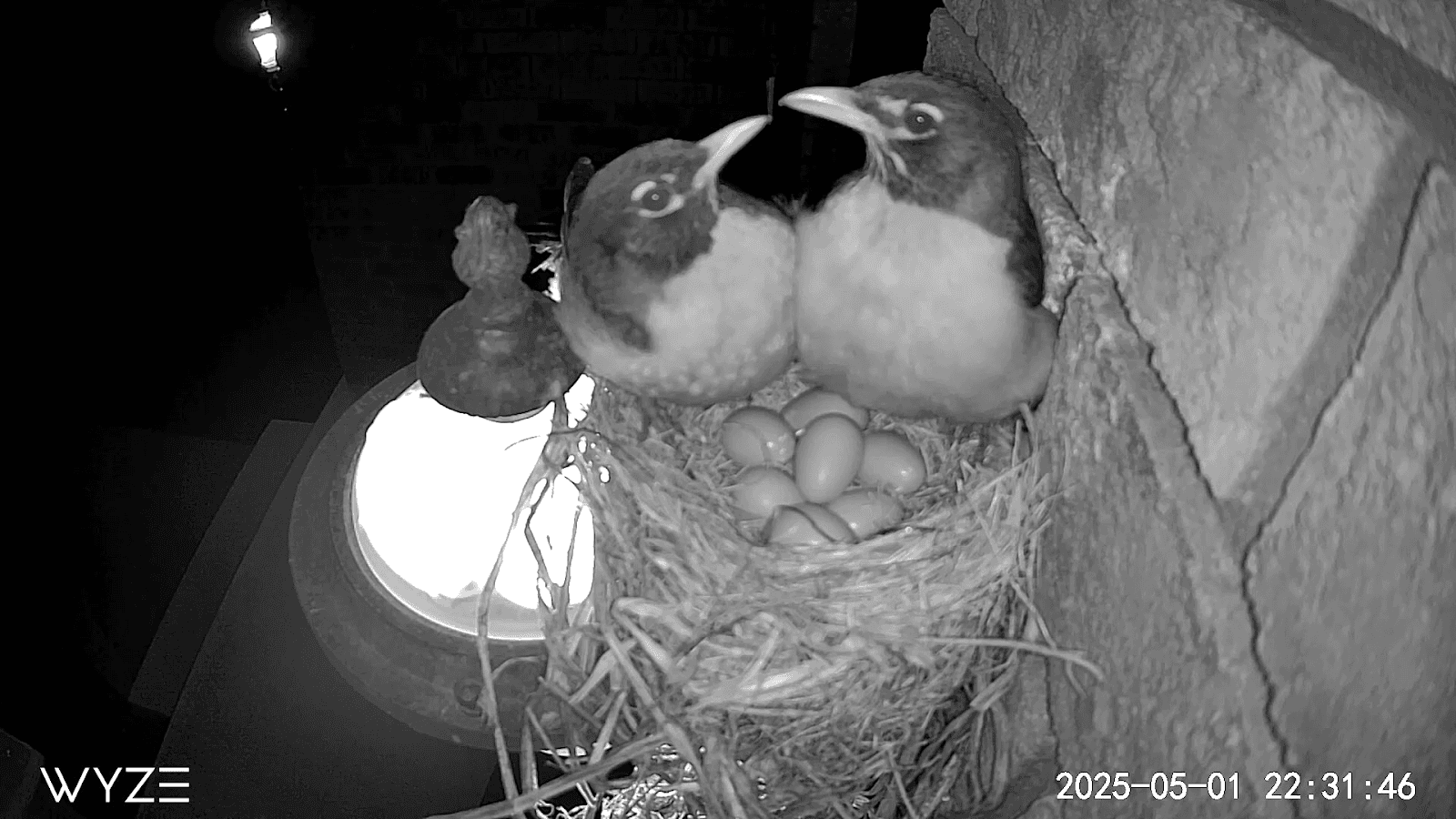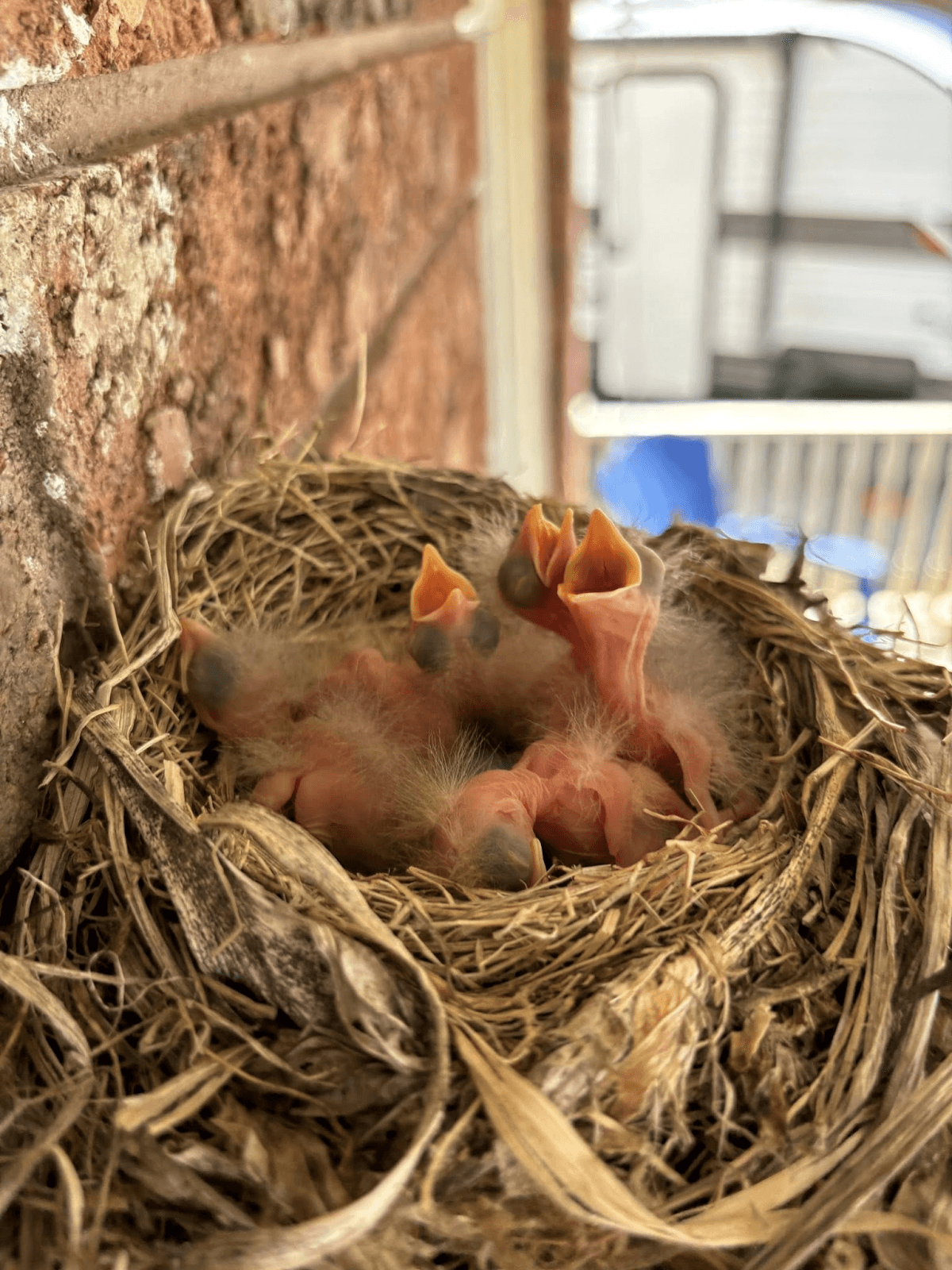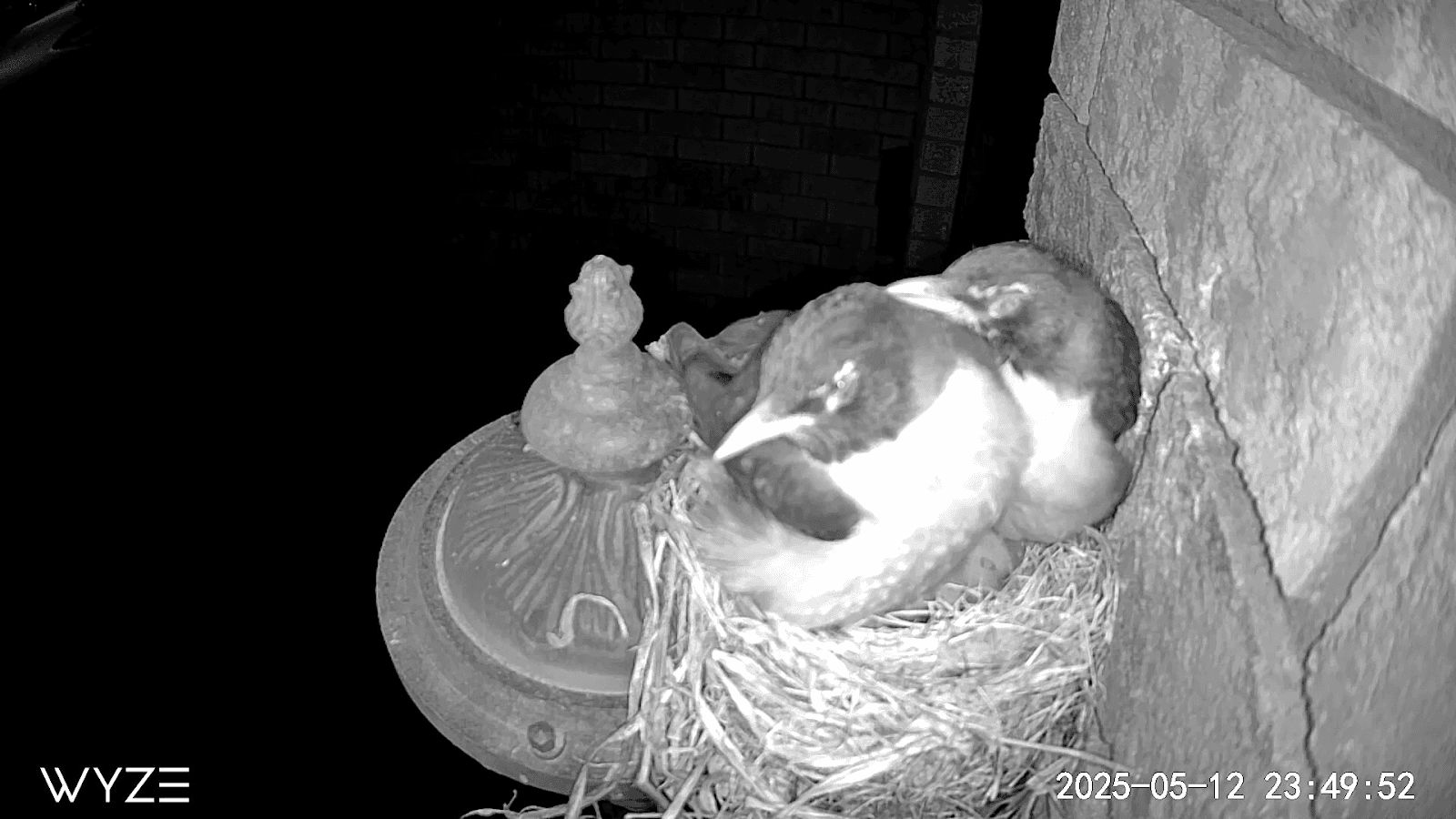Every year around this time, Debra Lynn Copeland’s front porch fills with heaps of discarded twigs and leaves. Then, like a magic trick, the mess is wedged carefully above a porch light and expertly woven into a tidy cup. Within days it fills with tiny, vibrant blue eggs as a mother robin settles in to raise a new brood.
So last month, when Copeland, a mom of three who lives in St. Thomas, Ontario, checked in on the nest and found two freshly laid eggs, she was cheered: Baby robins were on the way. Then things started to get strange. By the next day, there were four eggs. “I was like, ‘OK, wow, that was fast,’” Copeland says. “Usually they lay one a day.”
Copeland looked again and found six eggs; within a few days, the count had risen to eight. Robins typically lay just three or four. “This poor mom,” Copeland remembers thinking. “How does she even breathe?”
Curious about what was happening, Copeland set up a camera to record the nest, and that was when she made a startling discovery: There wasn’t one mother robin. There were two.

On Copeland’s porch, the competing mother robins—she could tell they were both female by the distinctive brood patch that both birds could be seen spreading over the eggs to keep them warm—were clearly nonplussed to find themselves sharing a nest. “The first few days, they were definitely not happy with each other,” Copeland says. “They were like, ‘Get out of my space. Get out of here!’ They would peck at each other and bite each other’s beaks and jump on each other until the other would leave. But they were just so stinking stubborn.”

Mystified by the development, she reached out to other birders on social media, including the nearly 230,000-member Backyard Bird Lovers group on Facebook, to ask whether anyone had seen something like this before. No one had. Sure, there have been plenty of cases of birds laying eggs in one another’s nests, sometimes leading to extra-large clutches like this one. But when Copeland’s 19-year-old son read up on the subject, he also couldn’t find any mention of a situation where both mother birds stuck around through incubation.
Eventually, a third robin started showing up—this time a male—who delivered small bites of food to both and looked on at the egg stockpile and the feuding mama bird pileup with what certainly looked like avian shock—a feathered dad who just came back from his pack of smokes and is not sure it was the right call. “He looks like he was having an existential crisis: ‘What is going on with my life?’” Copeland says.

It’s peculiar, to put it mildly. “Robins are known for being pretty territorial,” says Robyn Bailey, the project leader of the NestWatch program at the Cornell Lab of Ornithology. “They generally don’t tolerate outsiders on their breeding territory, which is what makes this all the more unusual. They tend to defend their nest site, especially, and females in particular will defend the nest site vigorously.”
At Cornell, NestWatch has worked with volunteers to track nesting birds for more than 50 years. While some bird species tend to breed cooperatively, nesting together in colonies and sometimes pitching in with feeding even if the nestlings aren’t their own, Bailey says that robins emphatically don’t. (And yes, Bailey’s first name really is Robyn; coincidentally, a robin was the first bird she ever successfully ID’d.)
At the National Audubon Society, the situation has been a head-scratcher. “I checked with our experts, and we don’t have a lot of information on this, actually,” Robyn Shepherd wrote back to my inquiry. Shepherd, the organization’s advocacy communications director, was particularly struck by the fact that the bickering mothers have spent so much of their time sitting directly on top of each other, a highly atypical adult behavior. “I think it’s safe to say it’s not common but can’t say for sure that it’s never happened before.”
Bailey said that there’s likely a simple explanation here: polygamy. “The typical relationship would be one female and one male for a breeding season,” she says. “But in the case where there might be a shortage of males, the females might have to just accept that they need to share this mate and their breeding territory. And if they’re going to do that, it makes sense to put the nests close together so that the male can feed both pretty close together or defend them more easily than if they were in two different spots.
“But it does sort of make sense,” she says. “If you have to be polygamous, you might as well share a home.” And unlike on, say, Sister Wives, the robins won’t have to move across state—or province—lines to evade meddling authorities.
Bailey pointed me toward a 1940s article about robin nesting patterns in The American Midland Naturalist in which author Joseph C. Howell detailed watching two female robins collaboratively construct a single nest that might have held as many as eight eggs, just as Copeland’s did. “During incubation both of the birds were frequently observed sitting on the nest together,” Howell wrote. “Sometimes one female would be on the back of the other, but more often they sat side by side. Usually both birds spent the night on the nest.”
The throuple has become a minor sensation on Bluesky, where I posted about it last week. (It even inspired one person to immortalize the quarrelsome mothers in a newspaper-cartoon-style illustration.) In the Backyard Bird Lovers group, where Copeland has continued posting daily robin updates for an increasingly obsessive audience, some wondered whether maybe her mother birds were related—a mom and daughter, perhaps, or siblings from a previous nest at the same spot. Bailey says that this is improbable: “You would be basically taking something that’s rare already and adding an extra-rare condition on it if they’re also siblings,” she says. “That feels a little unlikely.”
The frequency of such behavior is hard to judge. While Copeland can easily monitor the nest and the robin trio’s comings and goings around the clock thanks to both her camera and the nest’s proximity, those are relatively rare conditions. Robins are extremely common across North America, but it’s hard to know what those who nest in tougher-to-see areas get up to. If robin throuples have their own social media platform, they’ve yet to invite any humans to join.
The Copelands are animal lovers. They currently have a dog and a cockatiel and over the years have raised everything from guinea pigs and gerbils to frogs, turtles, and newts. “I’m definitely no expert,” Copeland says of her birding passion. “I just really love watching the animals around us and find it very fascinating and healing in this world where there’s just a lot going on.”

On Mother’s Day, the first baby robin broke through. It has since been joined by five more; the final two eggs have yet to stir, but Copeland is hoping all eight will make it into the world, though it’s possible that the blended robin family will have to settle for sextuplets. Both mothers and the father have begun taking off to hunt for food to bring back to the trio’s very hungry babies, and the growing nestlings increasingly force their disgruntled, if resigned, mothers to the side of the nest. One benefit of the situation has already become clear: There’s an extra parent on hand to help with childcare—increasingly in the form of worm procural.

Worried that the overly full nest might lead to eggs or chicks falling or being pushed out, Copeland bought a hanging pot that she filled with leftover nesting materials and soft plants from around the neighborhood and set it up directly under the nest. As a further failsafe, a bench about 4 feet under the nest was already covered in soft padding—which saved the day last week when one mother robin was spooked and took off suddenly, sending two eggs flying out. The eggs landed safely on the padding, and Copeland, who has carefully monitored the footage in real time, slipped them back into the nest minutes later. They were already showing “pips,” tiny fractures that precede a baby bird’s emergence from its egg, and they hatched soon after.

By now, the mother robins have settled into a cautious peace with each other. The night before we spoke, Copeland caught one robin sleeping with her beak resting on the back of the other. Copeland says they’ve started dive-bombing her when she visits the nest to take a picture but otherwise sit on her railing, cheeping furiously. “They really yell at you,” she says, and she’s tried to give them as much space as a home next to her front door will allow.
Will the triad endure? It’s unlikely—robins generally pick new mates each breeding season, and newly fledged offspring are usually sent on their way as soon as they’re able. But Copeland says that her backyard is full of chirping and begging baby birds. Next spring, she’ll be shocked if the robins, in whatever numbers they choose, don’t return to her porch once more.
